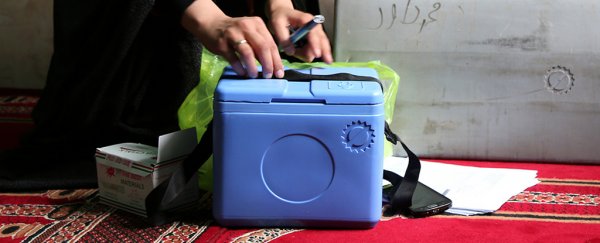Just 22 people contracted polio in 2017. It's a whisper away from eradication, but due to the challenges involved in getting the vaccine to where it's needed most, the extinction of the polio virus in the wild remains just out of reach.
The end might finally be in sight thanks to a new method for preserving the preferred inactivated form of the vaccine - this new method requires no refrigeration.
As a freeze-dried powder, the vaccine can now be shipped into places previously off limits, to provide much needed immunity to the handful of populations that are still at risk from this devastating illness.
Scientists from the University of Southern California worked with researchers from the drug manufacturer Integrity Bio to develop a process that removes the moisture from inactivated poliovirus vaccines (IPVs) without affecting their effectiveness, improving their stability at ambient temperatures.
"However, no matter how wonderful a drug or vaccine is, if it isn't stable enough to be transported, it doesn't do anyone much good," says the study's first author, Woo-Jin Shin.
Polio vaccines come in two varieties. The first was famously developed by Jonas Salk in the 1950s, and involves an injection of broken-up poliovirus particles.
A second method was developed the following decade by the Russian-born medical researcher Albert Sabin. Though it requires no needles, his easy-to-deliver oral vaccine is based on a live, weakened form of the virus, so carries some risk of catching the disease.
That risk isn't exactly huge. Only 96 cases of vaccine-derived polio occurred in 2017, and the chances of those with the virus suffering its debilitating symptoms are also extremely small.
Still, it's a risk we could do without. So the Global Polio Eradication Initiative is phasing out its use altogether and sticking to the injected vaccine.
Using IPV is certainly the safer bet, but as with most biological materials, light, temperature, and other environmental conditions make short work of its proteins, making it useless when it comes to inoculating against a disease.
If kept at a chill 2 to 8 degrees Celsius (35 to 46 Fahrenheit), vials of IPV can be stored for up to four years. Otherwise, they go off like fish on a summer's day.
Freeze-drying the vaccine's ingredients can help stretch out their used-by date considerably, a method already used to ship vaccines for measles, typhoid and meningococcal disease into remote corners of the globe.
But dehydrating IPV has proven more challenging, resulting in less than impressive stability at ambient temperatures.
Finding a new process isn't all that hard. At least, not in principle.
"Stabilisation is not rocket science, so most academics don't pay much attention to this field," says Shin.
What is hard is knowing which methods are winners, and which turn a potentially life-saving vaccine into an ineffective pile of dust.
So the team started by devising a new in vitro assay for determining the potency of IPV following its preparation.
They then went about sifting through various formulations for freeze-drying using high performance liquid chromatography to rapidly sort which ones would still work their magic.
The result was an IPV that could be kept at temperatures of up to 37 degrees Celsius (99 degrees Fahrenheit) for four weeks and be just as effective as non-freeze-dried vaccines that had been kept at a chilly 4 degrees Celsius (39 degrees Fahrenheit).
Tested on mice, the rehydrated form of the vaccine still provided the same level of immunity.
Polio is a disease most of us could be forgiven for thinking is already extinct. No cases have been recorded in the US since 1979.
Prior to immunisation, annual cases could be as high as nearly 60,000 during outbreaks. Among adults with paralytic forms of the illness, up to nearly a third faced death.
There are three strains of the polio virus. One was officially declared wiped out in 2015, some 16 years after the last of its kind was detected in India. Another hasn't been seen since 2012.
But that still leaves one variety persisting in communities in Pakistan and Afghanistan. If we're to truly see an end to it, and avoid a return to those epidemics, we'll need to overcome all obstacles.
The world need this vaccine to finish the job.
This research was published in mBio.
